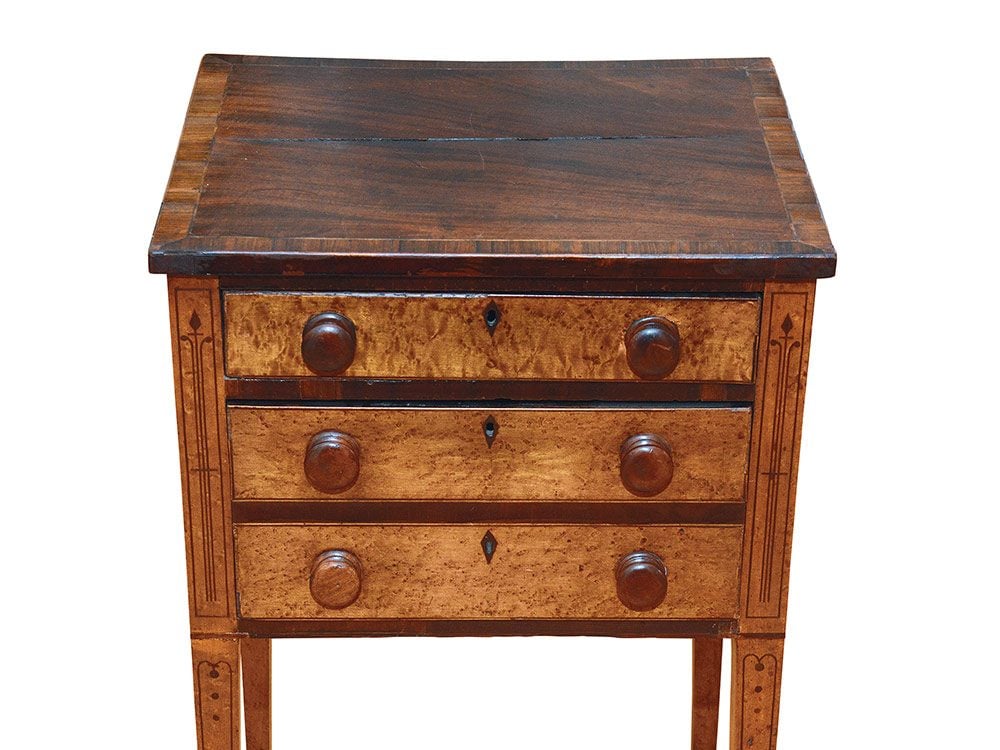Finding a New Home: The Dying Wish of an Antique Collector
On his deathbed, Halifax collector David Olsen was most concerned with his two-drawer Sheraton stand—a table built by 19th-century cabinet maker John Tulles and valued at $10,000.

An antique collector’s final wish
Jack Craft of Finer Things Antiques & Curios in Halifax, a friend and colleague of mine, wasn’t sure what to expect when he was summoned to the hospital bed of local collector Reidar (David) Olsen, who was gravely ill. As it turned out, Mr. Olsen wanted Jack’s help to disperse his superb collection of antique furniture, the majority of which was made in Atlantic Canada. In particular, he was most concerned about an exquisite, two-drawer Sheraton stand attributed to 19th-century Halifax cabinet maker John Tulles (1771-1827). Jack appraised the table at $10,000.
“It was a collection that was put together over many years and had several excellent 19th-century pieces in it,” Jack explained. “It was the dying wish of Mr. Olsen, who placed his collection with me, that I find the best possible home for the Tulles’ table.”
It didn’t take long for Jack to land on the idea of offering the table as a donation to Government House in Halifax. Government House is one of the oldest consecutively occupied government residences in Canada, and one of the oldest such official residences in North America. Jack contacted the executive director, Christopher McCreery, who immediately expressed interest in the piece and arrangements were made for the table to be donated. Jack said he was “pleased to see the table stay here in Halifax and in a setting where everyone can see this terrific example of Tulles’ work.” (Check out this Canadian’s incredible phonograph collection.)
“He only bought the best of the best.”
Jack recalled how he first came in contact with Mr. Olsen, whose given name was Reidar, but everyone knew him as David.
“I’d known who David was for 20-plus years, although he didn’t know me. I’d see him at local auctions and would always marvel at his discerning eye—he only bought the best of the best. After I opened my store 15 years ago, he became a customer and we struck up a good rapport. It wasn’t too long before we realized we had very similar tastes across many categories, and over the past five years, he became one of my most valued customers.”
In Nova Scotia, John Tulles is considered the best furniture maker of his time. Other experts have stated that he was the finest Canadian furniture maker of the early 19th century, but little is actually known about the man. Ross Fox of the Royal Ontario Museum, in research for an article on Tulles’ furniture, was able to ascertain that he was born on December 26, 1771, in Ferryport-on-Craig (now known as Tayport) in Scotland.
Mr. Olsen’s father was from Norway and served in that country’s merchant navy during WWII. His father met his mother, a resident of Mahone Bay, N.S., around that time, and they ended up marrying and settling in Nova Scotia. Shortly after that, David was born. (Take a peek at another Canadian’s impressive antique collection.)
“He enjoyed the research as much as the collecting.”
Jack also commented on Mr. Olsen’s passion for Canadian antiques. “He took an interesting approach to buying because his interests ranged from 18th century to mid-20th century, but his greatest loves were 19th-century Nova Scotia furniture and mid-20th century Canadian Maritimes studio pottery; the two seemed to work well together in a decorative setting.”
Mr. Olsen had no children and collecting was his true passion. He and his partner would attend auctions together and travel the countryside visiting antique shops and estate sales. He enjoyed the research as much as the collecting. When his home was cleaned out there were volumes of reference books, magazines and other periodicals related to the antiques trade stacked from floor to ceiling. He was a true scholar.
David’s cherished table is attributed to Tulles based on several distinct features, particularly the inlays found in his works. In the Sheraton style, it dates to about 1815. The main carcass is constructed of bird’s-eye maple with a two-drawer configuration comprising a single drawer over one larger, deep drawer faux-fronted to appear as two separate drawers. The cross-banded top is in mahogany. The tapered legs are string-and-dot inlaid and terminate in brass caps and casters. Identical inlays have been found on labelled pieces of Tulles furniture and documented in the book Heritage Furnishings of Atlantic Canada: A Visual Survey with Pertinent Points by Henry and Barbara Dobson. The Royal Ontario Museum in Toronto has three pieces in their collection that have been attributed to Tulles. And now Government House in Halifax has one, too.



